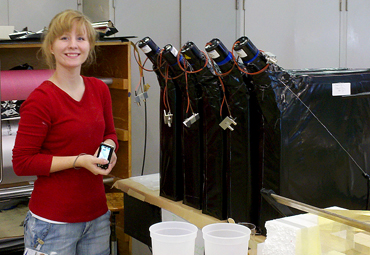AMES, Iowa - Melanie Waidanz couldn't believe what her physics professor was saying.
"I'm going to CERN," John Hauptman told the undergraduates in his classical physics course, referring to the European Organization for Nuclear Research and the home of the Large Hadron Collider. He explained he needed students to help with some projects he'd finish there over the summer. "If anyone wants to come along, send an email."
Waidanz, then a first-semester freshman and now a sophomore physics major from Glen Ellyn, Ill., opened her laptop and sent a note right away.
Hauptman, a professor of physics and astronomy, was facing a busy summer as part of the DREAM Project, an Italian-American collaboration led by Richard Wigmans, a professor of physics at Texas Tech University in Lubbock. Project collaborators are working to develop a new kind of particle detector for high-energy physics, a calorimeter to measure the energies of hadronic particles, subatomic particles made up of quarks, such as protons, neutrons and pions.
"The goal of the project is to develop the best detector in the world by far," Hauptman said.
To help make that happen, Hauptman's goal for the summer of 2011 was to build nearly a half ton of instrumentation designed to test one of the concepts behind the DREAM detector. It was going to be a big job at CERN. And so he asked if there were any students willing and able to help.
"I wasn't sure if he was joking at first," said Waidanz.
But she sent Hauptman a note, "If you're serious …"
Before long, Hauptman had assembled a team of 10 undergraduates, most of them freshmen: Hanna Arnold, a physics major from Fort Madison; Aaron Bazal, an electrical engineering major from Newton; Anthony de los Reyes, an electrical engineering major from Moline, Ill.; Laura Hansen, a physics major from Shenandoah; Riley O'Connor, a physics major from Altoona; Timothy Overton, a mathematics major from Indianola; Andrew Priest, a physics major from West Des Moines; Cody Ross, an electrical engineering major from Batavia; Priscila Torres, a physics and aerospace engineering major from Harrison, Ark.; and Waidanz.
Then Hauptman told the students about a hodge podge of projects, asked them to pick a few tasks and started them working on some ideas in an Iowa State lab.
One goal was to design, assemble and test a prototype instrument called a scintillating fiber hodoscope that tracks particle trajectories. Another was to build portable equipment capable of supplying 2,000 volts of power. And a major one was to polish plastic to glass quality and focus light onto photomultiplier tubes.
O'Connor explained that last project: When pions in a high-energy beam from a CERN accelerator strike the calorimeter, they create a shower of many other particles, including neutrons from broken nuclei. The neutrons hit protons in the scintillating plastic and emit light. An attached photomultiplier tube measures the light and the energy of the neutrons. The data is collected and used to determine the total energy of the incoming pion.
That instrument, in other words, is a fancy neutron counter.
The students' work for the DREAM Project wasn't an elaborate lab that provided all the guidance and materials the students would need. So there were some false starts, a few ideas that didn't work and even a small explosion.
"There was a lot of trial and error and figuring out the best way to approach these problems," said Hansen.
But the students kept at it and in late June moved their work to a scintillator lab at CERN headquarters near Geneva, Switzerland. Students arrived in staggered shifts, working in small groups for four or five weeks.
They polished, machined and epoxied the scintillating material. They made light-tight coverings and cages for the scintillators. They assembled the electrical systems. They hooked the electronics to a computer system. They took a few overnight shifts in the collaboration's control room. Then they assembled their work for initial tests with high-energy pions.
And it all worked. The Iowa State undergraduates had solved enough problems to take calorimeter measurements that had never been collected by any physics team.
"They did very well," Hauptman said. "Not only was the project designed and taken to completion, but all the counters were calibrated and worked perfectly. It was extraordinary."
There were, of course, some lessons learned: "I learned a lot about physics," said Arnold. "It's one thing to learn this in class and another to do it. I'll remember this physics forever. It was very inspiring. I want to do this for the rest of my life."

Hanna Arnold, a sophomore physics major from Fort Madison,
shows off a few of the neutron counters built by a team of Iowa
State undergraduates at the European Organization for Nuclear
Research.
Larger photo. Photo by John Hauptman.